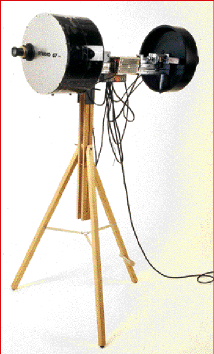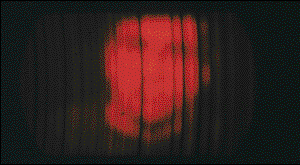Daniel C. McCarthy, Senior Editor/Special Projects
John Logie Baird's first attempts at producing a mechanical television during the 1920s relied on an objective lens to amplify the projected image. Predictably, the most his machine could produce were shadows. Seeking some means to augment the projection, he applied early amplification technology from EMI Electronics.
Nearly 80 years later, artist Peter Keene decided to reinvent mechanical television for an exhibit at the Electropolis Museum of Electrical Energy in Mulhouse, France. Seeking to advance on Baird's intent without departing from his medium, Keene selected photomultiplier tubes from EMI's current iteration, Electron Tubes Ltd.

Artist Peter Keene's interactive sculpture borrows heavily from 20th-century inventor John Baird's mechanical television. Keene's modern version substituted more efficient photomultiplier tubes for Baird's light cells. Although this created a brighter image for Keene, he remained faithful to Baird's 30-line picture definition. Courtesy of Peter Keene.
Baird's system integrated two metal discs spinning at 1000 rpm. Each disc was pierced by a spiral pattern of 30 1-mm holes and synchronized to scan the object. The transmitter end of his television projected a bright beam through the holes in the disc that, reflected off the subject, registered its image on EMI's photomultipliers. The image that was produced measured only 40 x 50 mm and carried a definition of 30 lines -- the number of holes in the disc.
"I thought, 'That's not possible,' " Keene said. "I'm not that interested in television, but I found the idea of an entirely mechanical system intriguing. I spent a year in the dark trying to work it out."
In initial attempts, he tried the purist approach, using the light cell tubes  from an old cinema projector. These were the only things available to Baird during the 1920s, and Keene learned that they provided little more success in this century.
from an old cinema projector. These were the only things available to Baird during the 1920s, and Keene learned that they provided little more success in this century.
Eventually, he opted to apply more modern tools, including vacuum tube photomultipliers from Electron Tubes for the photocell component of his television. The new approach produced results. "I think I had a glance, a small feeling, of how it was when Baird got his first picture," said Keene.
There were, however, two differences between Baird's and Keene's "first light." Baird's first televised images were of Bill, a ventriloquist's dummy; the first image Keene derived was of Elvis. The other difference is Keene's singular complaint that the images produced using Electron Tubes' technology were too good. "The quality is too good to be the quality of the original mechanical televisions -- even with 30 lines, you get a lot of detail," said Keene. "But it brought out all the imperfections in the image."